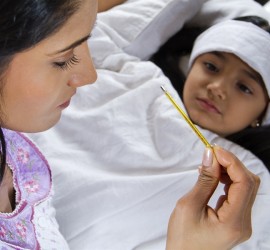
Photo: ImagesBazaar
According to a new study, being part of a big family heightens the risk of passing on viral infections that cause colds, flu and other respiratory woes. This risk increases with every additional person residing in the home.
The study, called BIG LoVE (Better Identification of Germs-Longitudinal Viral Epidemiology), was led by scientists at the University Of Utah School of Medicine. The results were published in the journal Clinical Infectious Diseases.
According to the research, which analyzed 26 households collectively made up of 108 individuals for about a year, people living in households without children were infected with viruses on average of 3-4 weeks in a year. When looking at homes with one child in them, the number of weeks where people were infected with viruses increased to 18. Families with six children had someone infected for up to 45 weeks of the year.
Young children are most likely the carriers for viruses in their families. The data showed that children under five years old usually tested positive for at least one virus in their nasal mucus for half of the year. Older kids and adults were half as likely to test positive for viruses yearly. Parents with younger children were also more likely (1.5 times) to get ill than their same-age counterparts who did not house young children.
“A lot of families go through wave after wave of illness. In fact, some of the kids we monitored had symptoms for 20 to 25 weeks in a row,” says co-first author Carrie Byington, M.D. “This study helps us to understand what is normal in young children, and can help us determine when illness should be a cause for concern.”
In India, the average household size is just under 6 people, according to the 2011 census. If such a family has 4 children in the home, the study data suggests that someone will be infected with a virus for 30 weeks of the year. That means parents could be caring for one sick child or another for over half the year. A large number of sick days could have an impact on parents’ jobs and the morale and energy of caregivers.
“I frequently get asked by parents, ‘Is this normal or is there something wrong with this child? They always have a runny nose’,” Byington said. “I can now just point to the study and say, ‘Your child is normal’. A child under 5 has a virus in the nose for half the year.”
However, about half the people who tested positive for a virus showed no symptoms of illness, which usually include coughing, fever and a stuffy nose. Whether or not a person gets sick seems to depend on the specific type of virus. People infected with bocavirus, which was the second most common virus, went up to 12 weeks but never showed symptoms. On the other hand, participants infected with influenza and parainfluenza viruses usually showed symptoms of the disease.
“If a child comes into the emergency room with severe respiratory illness and tests positive for rhinovirus, it might be a smart idea for doctors to make sure they’re not missing something else that could be the cause,” says co-author and professor of pediatrics Krow Ampofo.
In the future, the investigators intend to look into viral behavior in larger communities that live in other areas and are of different ethnicities.
Share your thoughts, leave a comment below. Please like FamiLife’s page on Facebook so that you get all our articles and others may find us.
